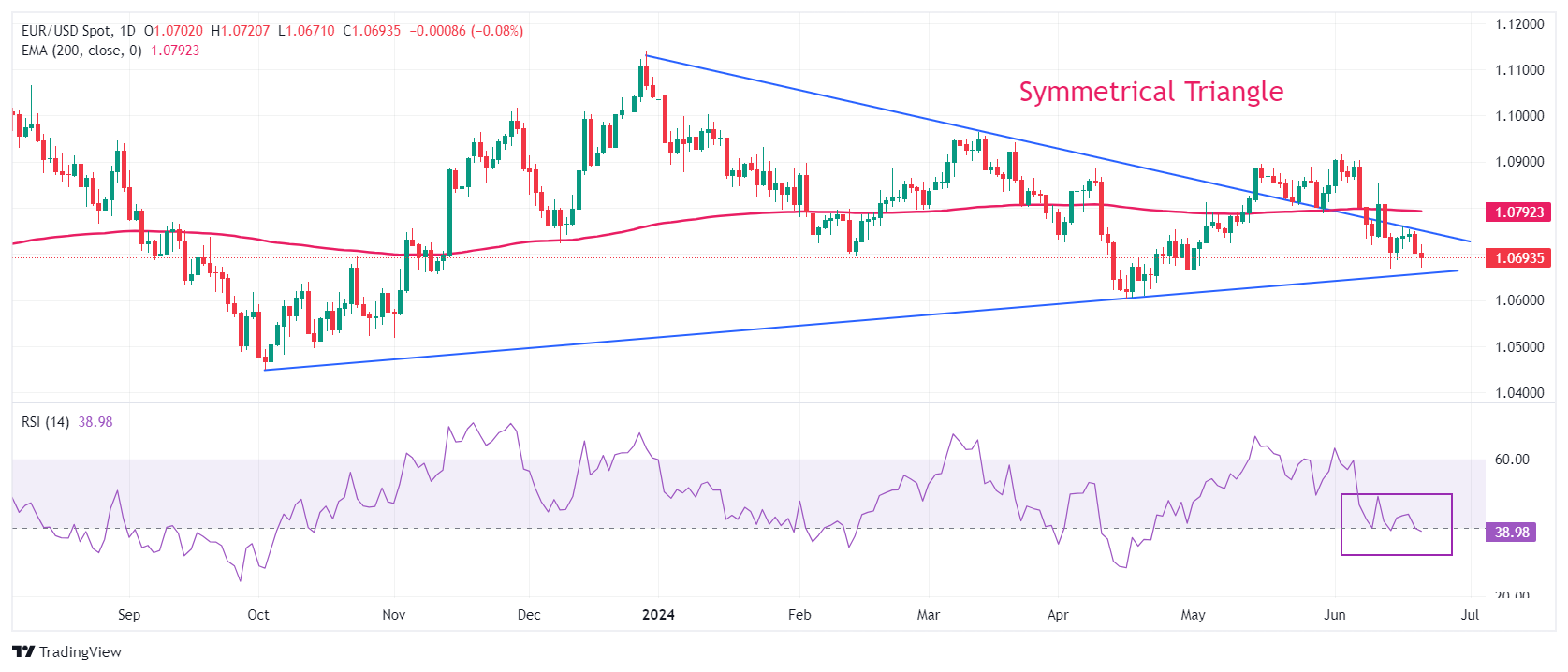EUR/USD Slumps Due To Weak Eurozone PMIs, Firm US Dollar
EUR/USD faces selling pressure in Friday’s European session due to multiple headwinds. The major currency pair declines to a six-week low near 1.0670 as the Euro weakens after downbeat Eurozone’s preliminary PMIs data that suggested the economy is losing momentum.
The HCOB PMP report, produced by S&P Global, shows that the Composite PMI unexpectedly declined to 50.8 in June from the prior release of 52.2 but managed to hold above the 50.0 threshold that separates expansion from contraction. Investors expected the Composite PMI to increase to 52.5. The Manufacturing PMI fell further into contraction territory while the Service PMI continued to suggest expansion, although at a slower pace than the previous month.
“New orders decreased for the first time in four months, feeding through to softer expansions in business activity and employment. Meanwhile, business confidence dipped to the lowest since February,” the report said.
Meanwhile, political uncertainty in France, the Eurozone’s second-largest economy, has been keeping the Euro on the back foot. Investors worry that the formation of Marine Le Pen 's-led-National Rally’s (RN) government after legislative elections would trigger financial woes in France. The RN has promised a lower retirement age, energy price cuts, more public spending, and "France first" economic policies in its manifesto.
On the monetary policy front, investors evaluate how many times the European Central Bank (ECB) will cut interest rates again this year. ECB Governing Council member and President of De Nederlandsche Bank Klaas Knot said on Thursday that he is comfortable with market expectations of one or two more rate cuts this year. The ECB cut interest rates for the first time in seven years at its June meeting.
Daily digest market movers: EUR/USD falls sharply as US Dollar jumps to almost seven-week high
- EUR/USD weakens as the US Dollar exhibits a strong performance due to the increasing policy divergence between the Federal Reserve (Fed) with other central banks from G7 nations. The US Dollar Index (DXY), which tracks the Greenback’s value against six major currencies, rises to an almost seven-week high near 105.85.
- Prospects for further policy divergence have strengthened as investors expect that the Fed will start reducing interest rates from the September meeting and will deliver one more rate cut in November or December. On the contrary, the ECB, the Bank of Canada (BoC), and the Swiss National Bank (SNB) have already entered a policy-easing phase. The SNB delivered its second consecutive rate cut in its meeting on Thursday. The Bank of England (BoE) is expected to start lowering interest rates in August.
- Fed policymakers emphasize keeping interest rates at their current levels until they see inflation declining for months. In latest interest-rate projections, Fed officials signaled only one rate cut this year.
- Market speculation of two Fed rate cuts this year was prompted by a higher-than-expected decline in the United States (US) inflation and slower growth in Retail Sales. On the inflation outlook, Minneapolis Fed Bank President Neel Kashkari said on Thursday that inflation would return to the bank’s target of 2% in up to two years. Kashkari remained concerned about high wage growth and acknowledged it is a key barrier to achieving price stability.
- In Friday’s session, investors will pay close attention to the US S&P Global PMIs data for June, which will be published at 13:45 GMT. The Composite PMI is expected to decline, although staying above the 50 level, signaling slowing growth in manufacturing and the services sector.
Technical Analysis: EUR/USD slides below 1.0700
(Click on image to enlarge)
EUR/USD extends its correction below the crucial support of 1.0700. The major currency pair declines toward the upward-sloping border of the Symmetrical Triangle pattern formed on a daily time frame. The long-term outlook has become uncertain as the pair establishes below the 200-day Exponential Moving Average (EMA), which trades around 1.0800.
The 14-period Relative Strength Index (RSI) declines below 40.00 for the first time in almost two months, suggesting that the momentum has leaned towards the downside.
More By This Author:
Silver Price Forecast: XAG/USD Stays Firm Above $29 Amid Firm Fed Rate-Cut Hopes
WTI Posts Fresh Six-Week High Near $81.00 On Geopolitical Uncertainty And Firm Fed Rate-Cut Bets
Silver Price Forecast: XAG/USD Recovers Strongly From $29.00 On Sluggish US Retail Sales
Disclaimer: The Content is for informational purposes only; you should not construe any such information or other material as legal, tax, investment, financial, or other advice. Nothing ...
more



